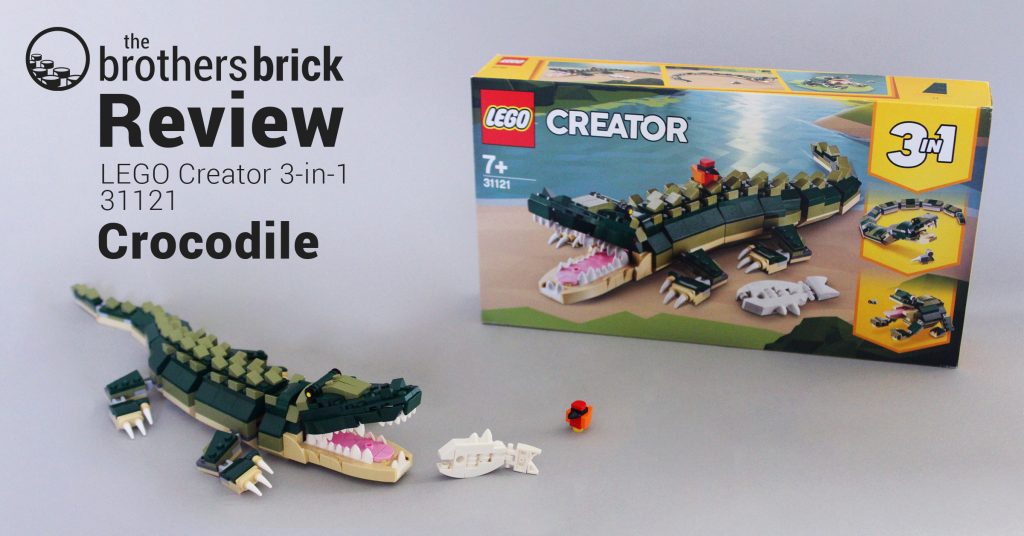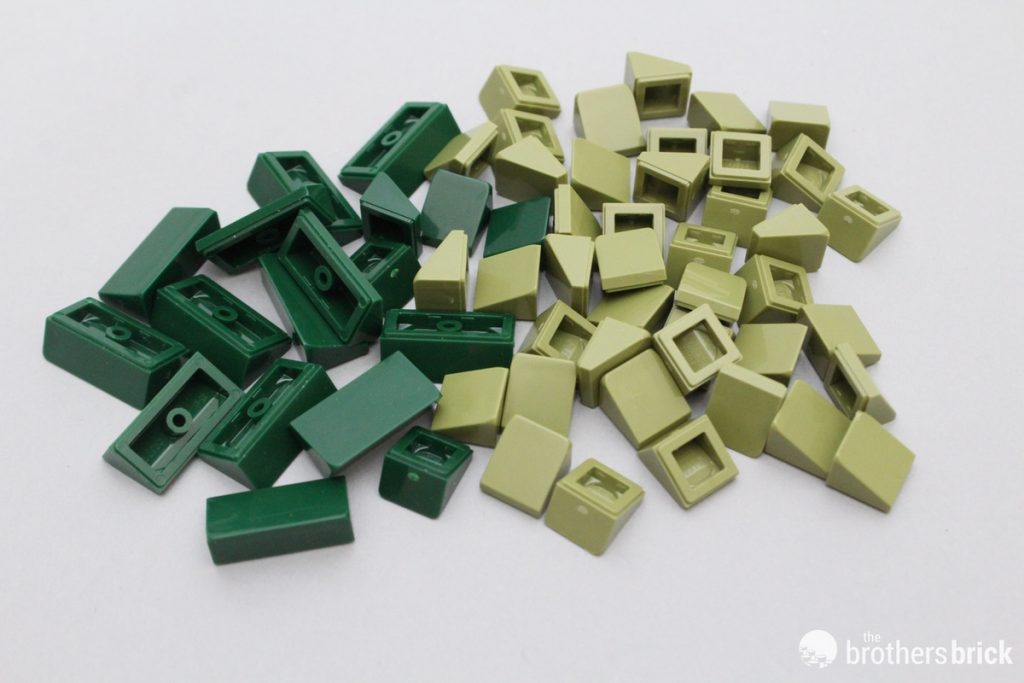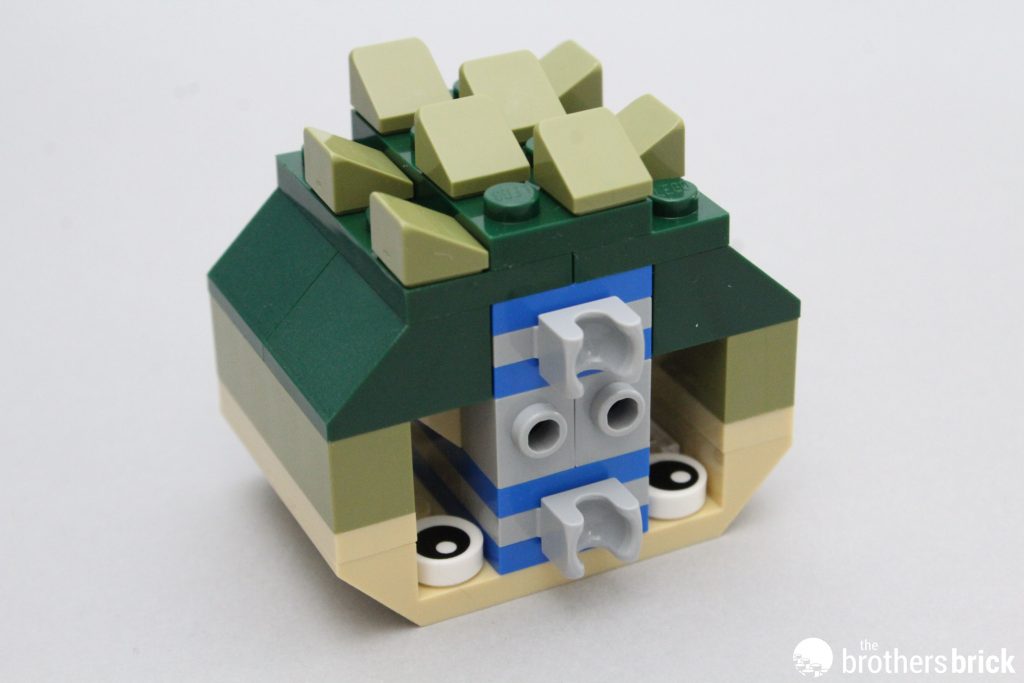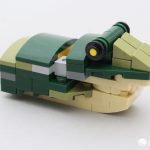Recently LEGO revealed the latest wave of Creator 3-in-1 sets. Right from the get-go this series looks to be pretty awesome, and now it’s time to see if they live up to the pictures! Per tradition, the line is showcasing at least one animal-focused kit, LEGO Creator 3-in-1 31121 Crocodile. The set contains 454 pieces and features not only instructions to build a crocodile, but also those for a snake or frog as well. It will be available June 1st in Europe, and August 1st in North America with a pricing of US $29.99 | CAN $39.99 | UK £24.99. Come along as we sneak a closer peek at this toothy critter.

The LEGO Group provided The Brothers Brick with a copy of this set for review. Providing TBB with products for review guarantees neither coverage nor positive reviews.
The box and contents
The thumb-punch box for this set is pretty unassuming. It’s not very big, for one thing. Just “your average $30 set” size. Therefore, it doesn’t scream awesome. The crocodile itself looks cool, but the other builds don’t really seem that striking on the box. At first glance it might be the kit that you pick up and say, “Ooh! Nice croc!” but put it back on the shelf for a set you might think has more mileage in terms of color and play features. Then again, for the reptile lovers, it’s a completely different story.
Inside the box are three small, numbered polybags, as well as three small booklets. Obviously, featuring the croc as the main model draws you toward building that one first, and the numbered bags are specifically for that purpose. But if the crocodile is not your first choice, coming back is a little more difficult in terms of finding pieces.
Taking a moment to explore some of the key elements in the set, we find that the collection of parts contains plenty olive and dark green pieces. If you’re looking for earthy colors, this is the kit for you. In particular, there are a decent handful of cheese slopes. This is the second highest quantity of olive cheese slopes ever featured in a set (41), after the giant 71043 Hogwarts Castle, as well as the highest quantity of dark green 2×1 slopes (13), just edging out 75978 Diagon Alley.
There are also a few new or recent recolors. Brand new are the bright pink 1x2x1 2/3 bricks with studs on 3 sides (Studs Not on Top, or “SNOT” bricks), tan 6×2 double inverted slope with cutout, and dark green 2×2 jumper tiles. Olive 1×6 plates and 2×2 plates with a notch only recently appeared for the first time in the 42110 Land Rover Defender and 10273 Haunted House. Another semi large quantity of parts are the solid handful of “Mixel” ball and socket joints that lend themselves to lots of possibilities in terms of posing.
Frustratingly, one notably absent element is a brick separator. This is a chronic issue with Creator 3-in-1 sets. Of all the LEGO lines, this one arguably needs them the most because the builder is strongly encouraged to take apart and build multiple things with the same bricks. But instead, brick separators only come in the largest Creator 3-in-1 kits, which is a real shame. For many first-time builders or gift-recipients, this is the line they find themselves starting in. With no or few other sets, they may not have a brick separator already, which can take away some of the fun and creativity that this line is supposed to embody.
The main build
Let’s jump right in with the first thing the instructions have you build: the accessory animals. It’s tough to count the amount of tiny birds LEGO has placed in their Creator sets. On one hand, they’re cute and sort of a tradition. On the other hand (and a bit more critical), they feel a little ho-hum and lazy. That said, the skeletal fish is excellent!
Aside from the bird and fish, bag #1 brings us the tail of the beast. Comprised of several Mixel joints, it has fairly decent flexibility. Right away it also becomes apparent that this guy is going to be a little bigger than the initial box art impression.
The second bag contains the elements to create the main body and legs. The first couple steps have you putting 1×1 round eye tiles in the belly of the croc. It’s kind of nice to not have the cartoon eyes on the face of this model. But it’s a bit odd to place them in the stomach. They serve no obvious functional purpose, and it only draws attention to a missed opportunity in terms of adding the rest of a goofy carcass from a recent meal. The only other explanation, after having placed other filler elements in odd locations within the body, is that they are to help the builder orient the sections in the direction they’re supposed to face.
The final bag has us rounding out the model with the coolest part: the head. It was a good way to create the instructions, by starting small and simple, and moving into more complexity. At the same time, you’re building up to the “wow” moment. Going the opposite direction would be anticlimactic and far less exciting. The head itself is fun not only because of its wide articulation, but also the nice use of those bright pink SNOT bricks to create the smooth interior of the mouth.
As mentioned previously, it’s a bit refreshing to not have silly googly eyes on this guy. The choice of using a yellow bar poking through round plates with holes on both sides was certainly the right one. You could always add the cartoon eyes (or others) if you felt like you needed more expression, but they already look great just the way they are.
When it’s all said and done, the finished crocodile is actually pretty hefty! At over a foot long, it’s bigger than how it first appears on the box, and it’s bulkiness gives it some durable “swooshability” worthy of recognition. It’s also fairly flexible in terms of posing, despite expected limitations.
The pile of leftovers isn’t all that exciting, but hey! More olive and dark green cheese slopes!
The first alternate model
Moving right along from four legs to zero, the next model up for review is the snake. To be honest, after having built the crocodile, hopes were not too high for this one. It’s hard to break down something cool just to rebuild it into something that looks less interesting. Snakes can be really fun, but there isn’t a lot to this one. You can’t completely blame the designers because they did a decent job within the constraints of element selection. Like the croc, it is built in sections, but there’s nothing awe-inspiring about them.
The head is where this one both stands out and falls flat. It’s naturally going to be the most interesting part of a brick-built snake, and for the most part it looks okay. They use the same exact technique for the eyes as the crocodile, and it looks just as good. The only problem is that without a tongue or other teeth in addition to the fangs, when the mouth is closed it looks almost like a sock puppet or gummy grandpa snake. Perhaps this is hypercritical because snakes aren’t always showing their teeth, but there’s something not quite right about it.
The best part about this alternate model is arguably the mouse. It could even be argued that it’s the cutest darn mouse LEGO has ever produced at this scale. It doesn’t get much better when you’re working with 8 pieces.
Altogether, it’s a decent build. If not for just having built the crocodile, this one might be more entertaining. The most interesting aspect are the ratcheting hinges that allow it to be posed with its head raised. Perhaps it deserves a fair nod. It has good flexibility, and that pose with its mouth open make this one actually look fairly cool.
The leftover pile is pretty large here, and it just makes you wonder… What awesome features could have been presented if the designers used a few of these pieces? Naturally, the intent is for builders to be inspired and have a full palette of pieces to make their own creations from. Still, it would have been nice to see something that added a bit of “cool” factor.
The second alternate model
Finally, we round out the trio with an amphibious critter. The fat little frog is a very fast build. The key play feature with this one is the ability to stick the tongue in and out of its mouth. It’s cute, especially with the little polliwog tail. The only issue here is that tiny tolerances play a role. You build the tongue as a separate pieces from the body, and then secure it into a slot with a plate that acts as a stopper. In this particular copy of the set, the 2×2 curved slopes sit a fraction of a millimeter high, causing the tongue to rub and catch with every pull. It certainly is not a smooth mechanism and it has created minor scuffs on the offending piece, but it’s still fun to play with!
The googly eyes finally come into the picture here, and this was the right choice. The frog is a more playful, silly model, and the tiny yellow pupils against black eyes just wouldn’t have conveyed the same image.
What about the frog’s customary companion animal? Of course it would be a fly. But the win here is how a convincing animal can be created with only two elements. Touché LEGO designers, touché. The mouse is more clever, but you have to give them props for this one anyway.
When it’s all said and done, the frog has better pose-ability than expected. When placed in awkward jumping positions, it has decent balance. Not extraordinary, but plenty for playability. An additional thing you’ll notice is that the build is very puppy-like. You could probably do a recolor and add ears, and nobody could tell it was once a frog.
As mentioned before, the primary play feature is the classic flicking tongue. In the GIF below, though slightly sped up, you may notice the slight hitch in the movement as it gets stuck while traveling within the slot. It’s possible that most others copies do not have this issue with smoothness. That said, the tolerance is indeed tiny.
Again we have a hefty pile of extras – even more than with the snake. Tons of potential lie within these elements. Another interesting thing to consider is which elements are only used in the main model, such as the olive bricks and SNOT elements.
Conclusions and recommendation
There you have it. There were several solid wins, and a handful of critiques. Often times when I review sets, it’s easy to find myself writing with an abundance of love and adoration, simply because I love LEGO. Lately, I’ve been trying to talk more about the things that I may have let slide before. But don’t let that deter you from appreciating the set. After all that, we’re left with the question: is it worth it?
And the answer is different depending on who you are. If you’re a parent seeking a set for their kiddo obsessed with animals (especial the scaly or amphibious kind), absolutely. The crocodile was a joy to build and was larger and sturdier than expected. It won’t bring a bunch of variety to their LEGO toybox, but it’ll be great for landscape once they finish with the recommended models. If you’re a builder simply eyeballing this set for the parts, you have a ton of great value here. It’s loaded with great earth-tone pieces in quantities that are actually useful, as well as a respectable handful of unique elements, all for under $0.07/piece. In general, Creator 3-in-1’s are excellent parts packs, both for children and adults alike, and despite its few shortcomings, I would definitely recommend this set.
While you’re here, take a look at some of our past reviews of Creator 3-in-1 sets including:
LEGO Creator 3-in-1 31121 Crocodile will be available June 1st in Europe for UK £24.99 and August 1st in North America for US $29.99 | CAN $39.99. It may also be available from third-party sellers on Amazon and eBay.
The LEGO Group provided The Brothers Brick with an early copy of this set for review. Providing TBB with products for review guarantees neither coverage nor positive reviews.


















































































